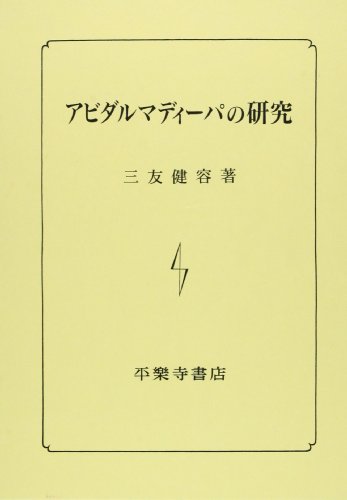1 0 0 0 日本・韓国佛教学交流の父金東華博士の一考察
- 著者
- 三友 健容
- 出版者
- JAPANESE ASSOCIATION OF INDIAN AND BUDDHIST STUDIES
- 雑誌
- 印度學佛教學研究 (ISSN:00194344)
- 巻号頁・発行日
- vol.51, no.1, pp.287-283, 2002
1 0 0 0 『アビダルマディーパ』における滅不待因論争
- 著者
- 三友 健容
- 出版者
- 日本印度学仏教学会
- 雑誌
- 印度學佛教學研究 (ISSN:18840051)
- 巻号頁・発行日
- vol.37, no.2, pp.916-922, 1988
- 著者
- 三友 健容
- 出版者
- 日本仏教学会西部事務所
- 雑誌
- 日本仏教学会年報 (ISSN:09103287)
- 巻号頁・発行日
- no.45, pp.p51-72, 1979
1 0 0 0 旧随界説について
- 著者
- 三友 健容
- 出版者
- JAPANESE ASSOCIATION OF INDIAN AND BUDDHIST STUDIES
- 雑誌
- 印度學佛教學研究 (ISSN:00194344)
- 巻号頁・発行日
- vol.29, no.1, pp.25-30, 1980
1 0 0 0 「アビダルマディ-パ」業品の検討-1-
- 著者
- 三友 健容
- 出版者
- 仏教思想学会
- 雑誌
- 仏教学 (ISSN:0387026X)
- 巻号頁・発行日
- no.7, pp.p65-93, 1979-04
1 0 0 0 『アビダルマディーパ』作者に対する二・三の問題
- 著者
- 三友 健容
- 出版者
- JAPANESE ASSOCIATION OF INDIAN AND BUDDHIST STUDIES
- 雑誌
- 印度學佛教學研究 (ISSN:00194344)
- 巻号頁・発行日
- vol.27, no.1, pp.221-225, 1978
1 0 0 0 アビダルマ仏教における無表業論の展開-1-
- 著者
- 三友 健容
- 出版者
- 立正大学仏教学会
- 雑誌
- 大崎学報 (ISSN:02891174)
- 巻号頁・発行日
- no.129, pp.p119-142, 1976-12
- 著者
- 三友 健容
- 出版者
- JAPANESE ASSOCIATION OF INDIAN AND BUDDHIST STUDIES
- 雑誌
- 印度學佛教學研究 (ISSN:00194344)
- 巻号頁・発行日
- vol.25, no.2, pp.718-722, 1977
1 0 0 0 倶舎論における svabhava について
- 著者
- 三友 健容
- 出版者
- JAPANESE ASSOCIATION OF INDIAN AND BUDDHIST STUDIES
- 雑誌
- 印度學佛教學研究 (ISSN:00194344)
- 巻号頁・発行日
- vol.21, no.1, pp.359-362, 1972
1 0 0 0 プドガラ輪廻論と有部業論との一考察 (聖誕750年記念特輯)
- 著者
- 三友 健容
- 出版者
- 立正大学仏教学会
- 雑誌
- 大崎学報 (ISSN:02891174)
- 巻号頁・発行日
- no.125, pp.299-312, 1971-07
1 0 0 0 OA 『アビダルマのともしび』第2章根品(4)(中村瑞隆先生追悼号)
- 著者
- 三友 健容
- 出版者
- 立正大学
- 雑誌
- 大崎學報 (ISSN:02891174)
- 巻号頁・発行日
- vol.160, pp.A35-A77, 2004-03-31
1 0 0 0 OA アビダルマのともしび : 第五章随眠品翻訳研究(2)
- 著者
- 三友 健容
- 出版者
- 立正大学
- 雑誌
- 法華文化研究 (ISSN:02871513)
- 巻号頁・発行日
- vol.31, pp.1-68, 2005-03-20
The Abhidharmadipavibhasaprabhavrtti (ADV.) is quite a unique Sanskrit manuscript discovered from a Tibetan monastery. It has very important discussions between Mahayana and Sarvastivadin. Mahayana criticized the traditional school, Sarvastivadin as Hinayana (Inferior Vehicle). Traditional schools were, however, said to comment no word against Mahayana Nobody succeeded in translating ADV. into the modern language since Dr. Jaini published it in 1957, because this work requires us a sufficient knowledge on the Abhidharma theory using the commentaries kept in the Chinese Canon and the Tibetan Tripitaka. In this paper, the part (Verse No.298-382) of the chapter V of the ADV. is translated into Japanese with detailed footnotes.[Verse No.298-311] The fundamental principle of the Sarvastivada school, namely, the reality of the past and future elements, is discussed here examining four leaders opinion of the Sarvastivada school and the Parinamavada of Samkhya, the Guna of Vaiseshika. [Verse No.312-324] Dipakara criticizes the Darstantika who supports niratmaka (no intrinsic nature). The ADV. quotes Kumaralata's view supporting the Vaibha-shika viewpoint. It also examines the doctrine of Sunyatavada, and contains a valuable reference to the Tri-svabhavavada of the Kosakara, Vasubandhu who is described as a Mahayanist fallen from the Sarvastivada.[Verse No.325-359] The ADV. deals with different anusayas obtaining in different states of mind. The AKBh. is very brief and explains this point by way of an illustration of the sukhendriya. The ADV. devotes twenty-five verses to this topic.[Verse No.360-370] The ADV. devotes to the exposition of other klesas grouped as asrava, ogha, yoga, upadana, samyojana, bandhana and grantha.[Verse No.371-383] The upaklesas or minor klesas collected in the Kshdraka-vastu (corresponding to the Pali Khuddaka-vatthu-vibhanga) are dealt in the ADV-Vrtti. The AKBh. is very brief and mentions only three upaklesas. The last portions of this chapter containing details on the klesa-prahana and klesa-parijna are lost.
1 0 0 0 『アビダルマのともしび』第5章随眠品翻訳研究(1)
- 著者
- 三友 健容
- 出版者
- 立正大学大学院文学研究科
- 雑誌
- 立正大学大学院紀要 (ISSN:09112960)
- 巻号頁・発行日
- no.22, pp.1-35, 2006
1 0 0 0 桜部建著「倶舎論」仏典講座十八
- 著者
- 三友 健容
- 出版者
- 大谷大学佛教学会
- 雑誌
- 佛教学セミナー (ISSN:02871556)
- 巻号頁・発行日
- no.34, pp.p66-69, 1981-10
1 0 0 0 IR 『天台四教儀』と『天台八教大意』
- 著者
- 三友 健容
- 出版者
- 身延山大学東洋文化研究所
- 雑誌
- 東洋文化研究所所報 = Journal, Research Institute of Eastern Culture (ISSN:13426605)
- 巻号頁・発行日
- no.18, pp.1-34, 2014-04
1 0 0 0 IR 中村瑞隆博士の思い出(中村瑞隆先生追悼号)
- 著者
- 三友 健容
- 出版者
- 立正大学
- 雑誌
- 大崎學報 (ISSN:02891174)
- 巻号頁・発行日
- vol.160, pp.31-32, 2004-03-31
1 0 0 0 『アビダルマディーパ』における『本論』
- 著者
- 三友 健容
- 出版者
- 日本印度学仏教学会
- 雑誌
- 印度學佛教學研究 (ISSN:00194344)
- 巻号頁・発行日
- vol.55, no.2, pp.875-867,1271, 2007
There are many untitled "<i>Sdstras</i>" which are quoted in the <i>Abhidharmadipa</i>, which I will abbreviate here as ≪<i>ADV</i>≫. Needless to say, we can understand what the author of the <i>ADV</i> stands upon by checking these quoted texts.<br>There are over 40 examples where Vasubandhu, the author of <i>Abhidharmakosabhasya</i> (<i>AKBh</i>), used "<i>Sastra</i>" in his text. Of these examples, the title of the <i>Prakarana-sastra</i> and the <i>Jñana prasthana</i> are known as the most common. On the other hand, "<i>Sastra</i>" is used in 20 sentences in the <i>ADV</i>. Of these, three refer to texts that are non-Buddhist, and the other 17 examples seem to be quoted from some of the so-called <i>Six pada-sastras</i>.<br>I have tried to check the standpoint of the dipakara, the author of the <i>ADV</i>, by researching these quoted "<i>Sastras</i>". Basically, the dipakara specifically mentions the title of "<i>Sastra</i>" only in reference to the <i>Prajñapti-bhasya</i>, <i>Prakarana-sastra</i> and the <i>Jñana-prasthana</i>. I could not find the titles of <i>Dhatukaya</i> and <i>Vijñana-kaya</i> mentioned anywhere, but I was able to identify sentences quoted from the <i>Abhidharmâvatara</i>, the <i>Prakarana-sastra</i>, the <i>Samgiti-paryaya</i>, the <i>Dharma-skandha</i>, the <i>Jñana-prasthana</i>, the <i>Mahavibhasa</i>, the <i>AKBh</i>, the <i>Nyayanusara</i> and the <i>Samayapradipika</i> by researching the use of the word of <i>sastra</i>. The dipakara even adopted the opinion of the <i>AKBh</i> when the latter represented the correct doctrine of the Sarvastivadin school.<br><i>AKBh</i> refers to "<i>Mahavibhasa</i>" as simply "<i>Vibhasa</i>", and the masters mentioned there by the term "<i>vaibhasika</i>". The <i>ADV</i>, however, refers to the same text as "<i>Vaibhasa</i>". It is not clear why <i>ADV</i> uses this form.<br>There are two possibilities why <i>ADV</i> uses the form "<i>Vaibhasa</i>":<br>1) "<i>Vaibhasa</i>" comes from the rule of the Sanskrit grammar which states that when a noun changes its vowel to vrddhi form, it means "that which belongs to or is affiliated with the original noun." In this case it means texts which belong to "<i>Vibhasa</i>."<br>2) <i>ADV</i> intentionally changed the word used by the dipakara's rival, Vasubandhu, because the dipakara hated him. In fact, the dipakara created many original expressions from words previously used in the <i>AKBh</i>.<br>I would like to suggest that the most likely possibility is the first. This would mean simply texts belonging to the Sarvastivadin School, because it is difficult to believe that the dipakara changed the title of the original text.<br>The major difference between the <i>ADV</i> and the <i>AKBh</i> is that the dipakara uses texts of the Madhyamika and Yogacaya schools to criticise Mahayana Buddhism.
1 0 0 0 『般若灯論』における説一切有部説 (二)
- 著者
- 三友 健容
- 出版者
- 日本印度学仏教学会
- 雑誌
- 印度學佛教學研究 (ISSN:00194344)
- 巻号頁・発行日
- vol.34, no.2, pp.778-784, 1986



